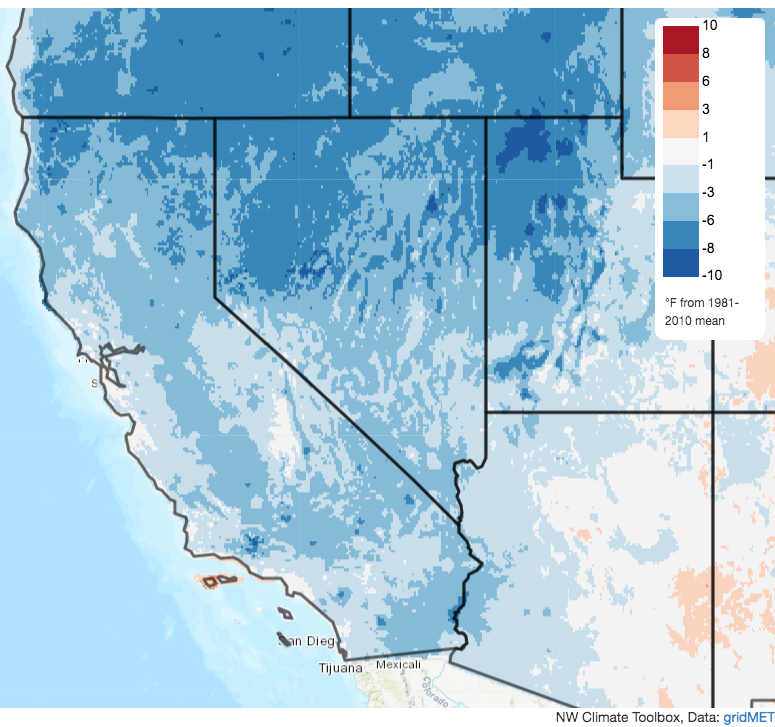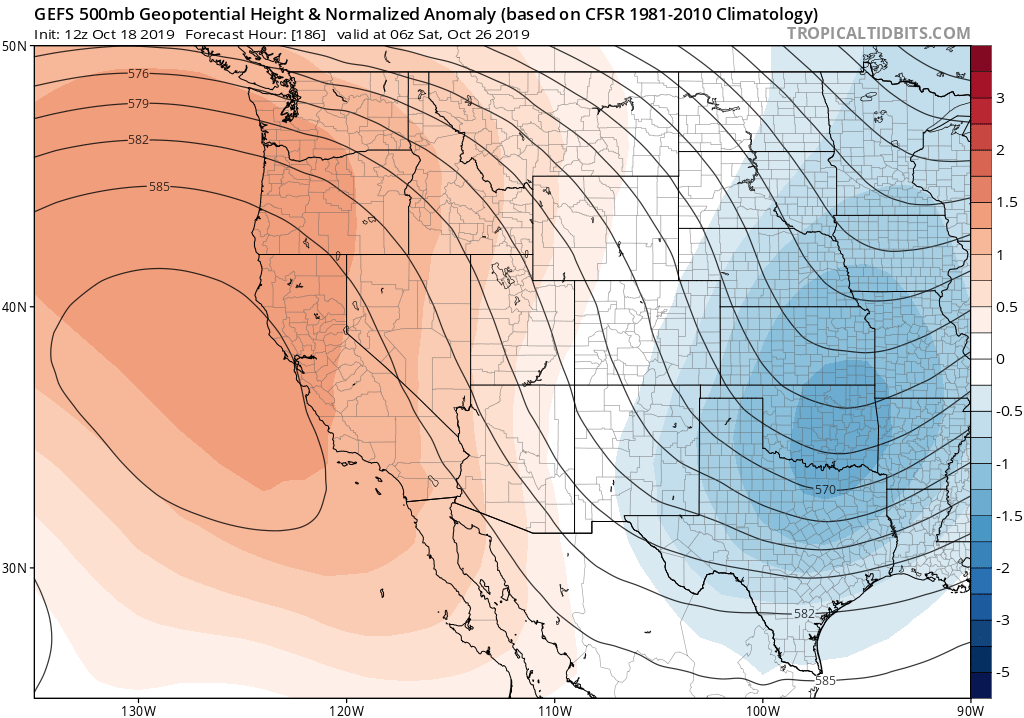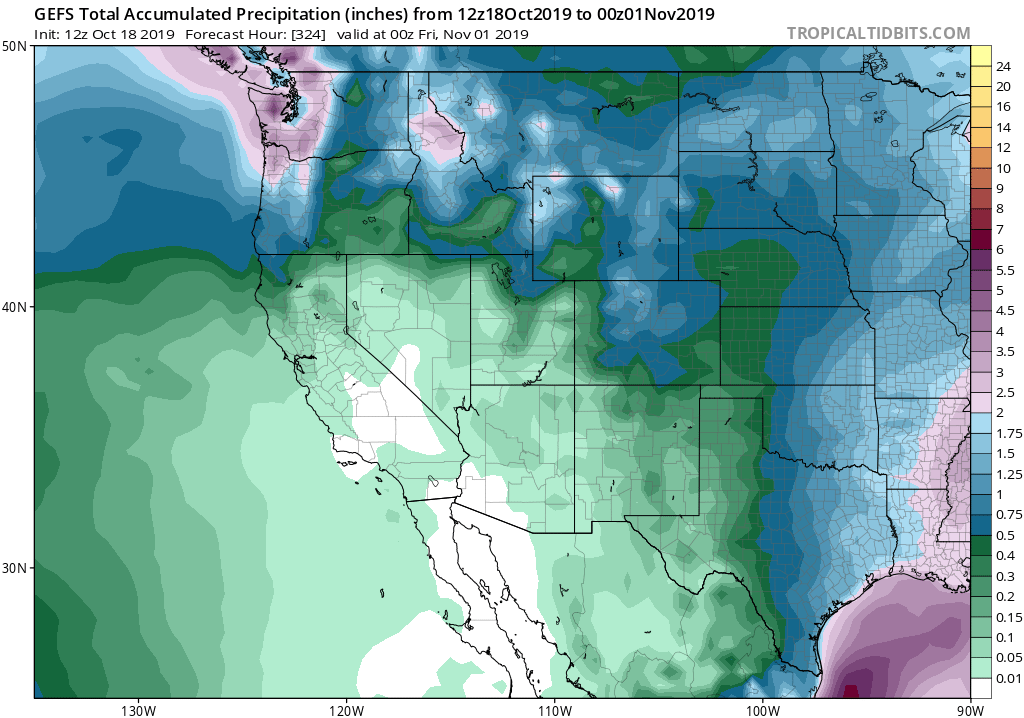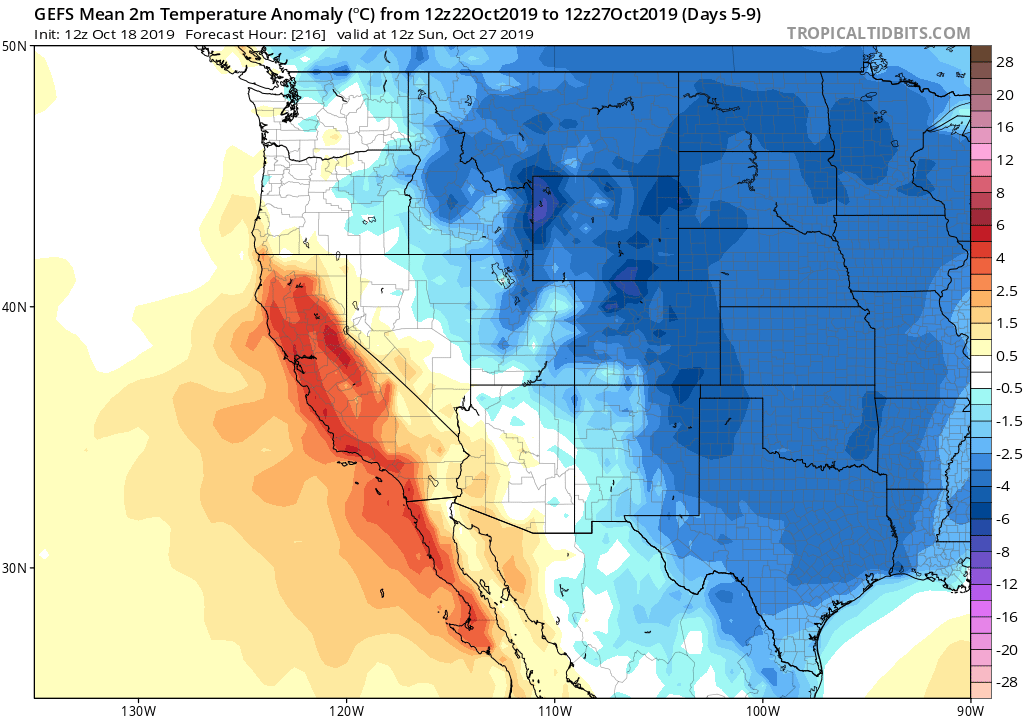Very dry (but cool) conditions persist for southern 3/4 of state

The second half of September, and the first half of October, have been quite dry over most of the state (except in some portions of far NorCal)–but relatively cool throughout. Several strong offshore wind events have already occurred this season (and more may be on the horizon), but to date these have been relatively cool autumn wind events. Generally speaking, the observed conditions over the past month are not terribly unusual for early autumn in California–a month that is typically pretty dry in this part of the world (with some notable exceptions). If the present dryness extends into November–which some models are currently suggesting–that will become a bit more unusual.
Warming trend to come as West Coast ridge builds; fire season continues until further notice

Despite recent relative coolness, however, much warmer temperatures appear to be on the way as a strong ridge builds along the West Coast. Additional offshore wind events appear to be on tap, as well, as weak/cool systems slide just to the east of California and leave strong surface pressure gradients in their wake. Unlike the offshore flow events earlier this month, these ones will be associated with unusually warm (and in some cases, genuinely hot) temperatures–especially along the immediate coast. Therefore, fire weather conditions could become extreme or even critical once again at various points over the next 10+ days as these periodic wind events coincide with warmer temperatures.

Unfortunately, outside of some sprinkles/light showers in the far north, precipitation is not on the horizon over the next 10 days and quite possibly into early November. That means that fire season will effectively continue until further notice–and may even briefly re-emerge in the relatively localized patches of NorCal that saw fire-mitigating rains in late September. It’s important to folks not to let their guard down regarding the potential for wildfire until the season is truly over–and at the moment that does not appear likely to occur in the next 2-4 weeks.

A few thoughts on “Public Safety Power Shut-Offs”
In October, Northern Californians experienced PG&E’s first widespread “Public Safety Power Shut-Off,” triggered by weather forecasts calling for strong offshore winds and extreme wildfire risk conditions. This intentional, pre-emptive power outage affected over 2 million people, and included areas well outside of the traditional strong wind corridors in California’s hills and west-sloping canyons (due to the fact that transmission lines supplying power to these areas pass through high risk zones). By virtually all accounts, this PSPS…did not go well.
I’m not going to get into the details in this blog post, as the finer points mostly relate to public policy, corporate bankruptcy, and the legacy of deferred maintenance–topics on which I am no expert. Indeed, there a number of excellent pieces of journalism out there that are highly worth reading (here, here, and here). But since many folks have suffered through these recent blackouts, and because more may be on the horizon, I will offer a few thoughts outlining my own personal perspective as a California climate scientist:
- Recognizing the existing weaknesses and flaws in California’s present-day energy transmission system, and that powerlines have been directly implicated in an alarmingly high fraction of California’s recently deadly & devastating wind-driven wildfires (including the horrific Camp Fire in Paradise last year), it is likely that targeted power shut-offs during extreme wind events will indeed prevent the ignition of *some* fast-moving and potentially catastrophic fires.
- Not all fast-moving and potentially catastrophic fires are ignited by powerlines. Shutting the power off preemptively may actually increase the risk associated with these other fires, as communication systems may be down (complicating evacuations) and critical firefighting infrastructure may be compromised in some places. Also, new ignition sources may emerge–particularly gas-powered generators used during outages.
- As implemented earlier this month, PSPS outages effectively shift a considerable burden from a private utility to communities across the state in a highly inequitable way. For many folks, these outages are more than an inconvenience–ranging from those who had to discard all the food in their powerless refrigerators to people dependent on electrically-powered medical devices. Indeed: early estimates are that this single PSPS instance may have collectively cost Californians $2 billion or more.
- The thresholds being used by PG&E to trigger PSPS outages appear to be so low that they will be reached with some regularity even in the present climate (perhaps once every 1-2 years for events affecting 2+ million people, and as often as 5-10 times per year for more localized outages). In a warming climate, it is plausible that these thresholds could be reached for a significant portion of the September-November period during certain years.
- For these reasons, I would suggest that targeted PSPS outages may be a temporarily “necessary bad idea”–an important (if blunt) tool to reduce the risk of wildfire catastrophe in the short term, but clearly unsustainable in the long (and even medium) term.
If you’re interested in a slightly longer-form version of my thoughts on this, I’d encourage you to listen to my recorded KQED Forum conversation from earlier this month (link here).
Spectacular tornado footage from…Davis, California?
In late September, a cool and otherwise unremarkable “inside slider” type system brought a few thunderstorms to the western slopes of the Sierra Nevada and parts of the Sacramento Valley. Aside from the locally wetting rainfall that temporarily dampened fire season in those regions, the most striking result was a surprisingly robust and isolated tornadic supercell thunderstorm the spun up just east of Woodland and moved slowly southward toward Davis (home of my alma mater). This cell managed to produce deep & accumulating large hail north of town and several strong gustnadoes along the storm’s outflow. But most spectacular was the full-fledged tornado that developed on the dry side of the storm, which moved mostly through open fields and an almond orchard. This tornado was widely filmed and photographed from multiple angles, and yielded what was (in my opinion) the most spectacular tornado footage ever recorded in California (I recommend playing the video below with sound on, for full effect). The NWS in Sacramento ultimately rated this tornado an EF-0, and there were no reports of significant damage.
California now has operational earthquake early warning system!
At long last, and after many years of effort, California now joins the ranks of other high earthquake risk regions (like Mexico and Japan) with functional earthquake early warning systems. The new system in California is intended to provide as much as 30-45 seconds of warning prior to the onset of strong shaking during damaging earthquakes throughout most of the state. Warnings will be sent out via the MyShake app (which you would need to download) and via Wireless Emergency Alerts (which will be sent automatically to all cellular phone users, but will probably be somewhat slower). Don’t expect to receive alerts for every quake–the system is designed to alert only when shaking is projected to be potentially damaging. And the system won’t help much if the earthquake is very nearby–there just won’t be enough time to send warnings out. But in many cases, this new tool will offer tremendous earthquake harm-reduction benefits–mainly as a result of the automatic shut-off protocols that it will enable (for trains, pipelines, elevators, surgeons, etc.)–but it may also allow individuals to move themselves out of risky situations (proximity to large windows, masonry facades, unstable objects, for example). On the whole, I’d say that this represents a significant (and exciting) milestone in California earthquake risk mitigation.
Discover more from Weather West
Subscribe to get the latest posts sent to your email.